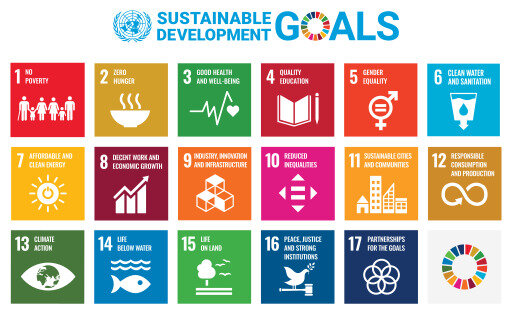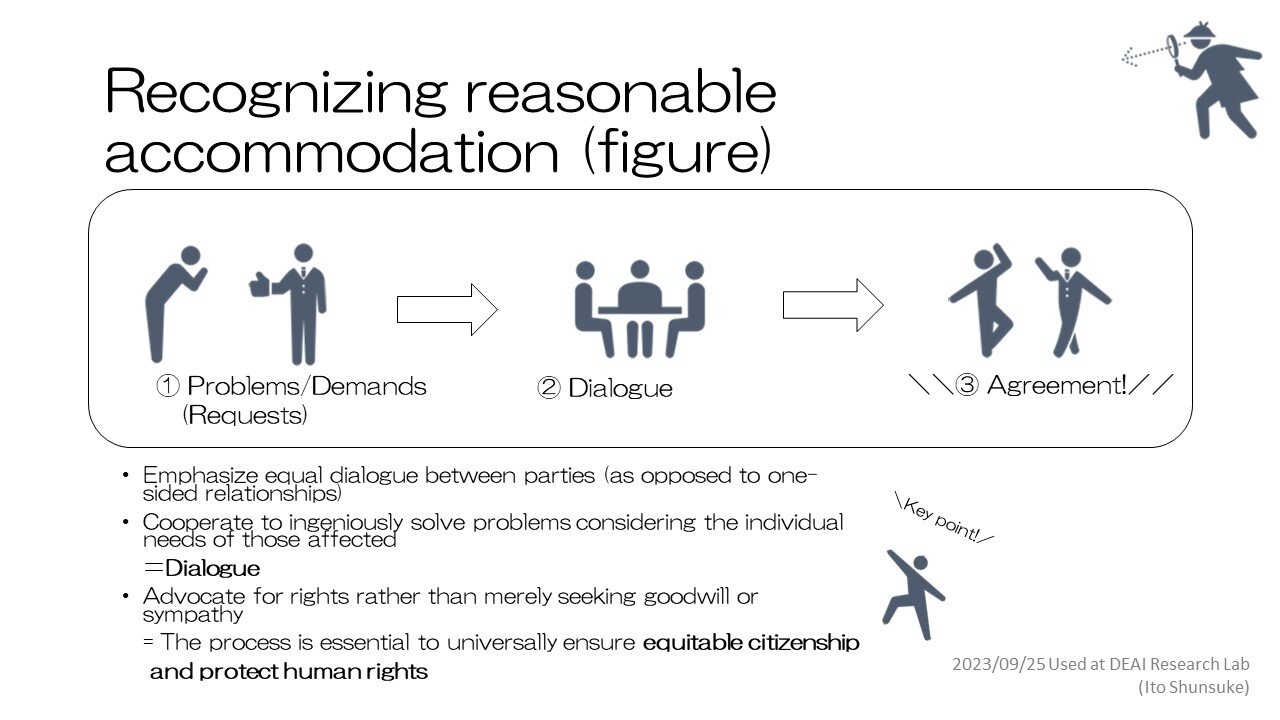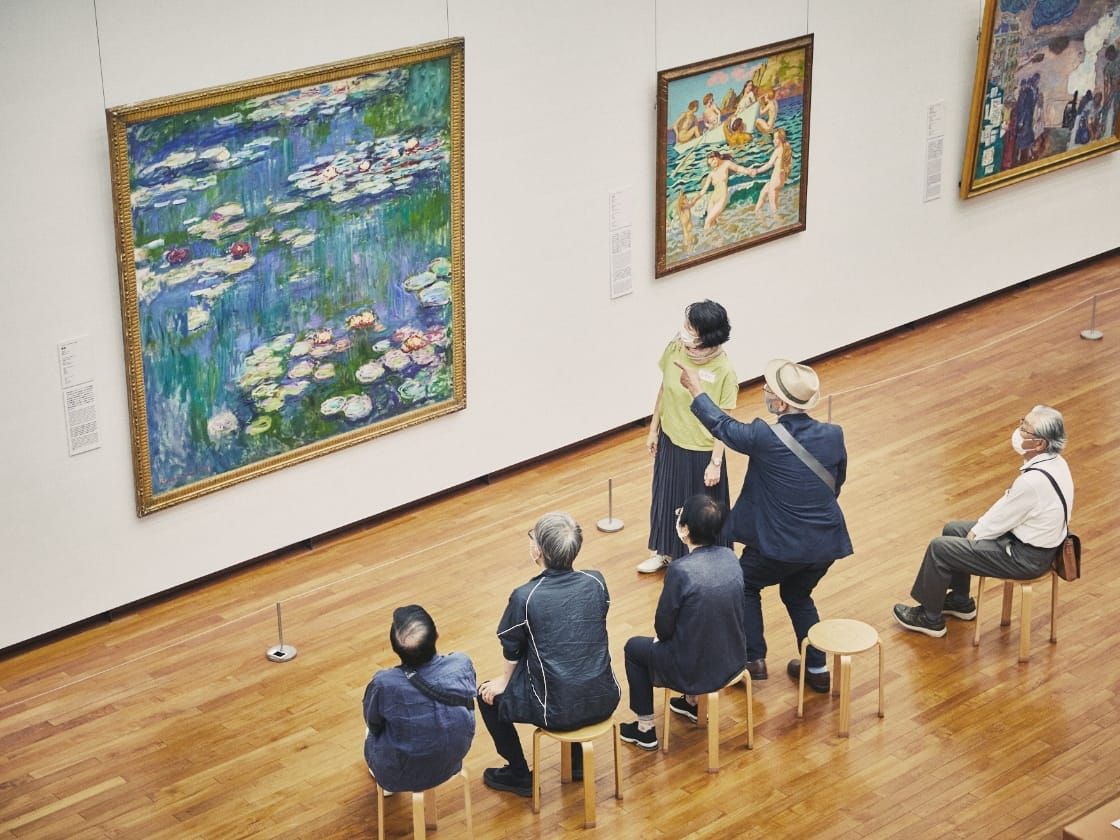Launch of the DEAI Research Lab. and Reasonable Accommodation
Suzuki Chikako
Curator, Learning, National Center for Art Research
In September 2023, a research group called the DEAI Research Lab. was launched as part of the National Center for Art Research’s accessibility project.
DEAI is an acronym comprising the first letters of the following four words: Diversity, Equity, Accessibility, and Inclusion. At the DEAI Research Lab, we research the global DEAI trends and investigate specific methods and requirements for improving museums’ accessibility. On the first year, four outside experts with relevant specialized knowledge joined us to conduct research on reasonable accommodation in museums.
What is DEAI?
| D | D: Diversity |
|---|---|
| E | E: Equity |
| A | A: Accessibility |
| I | I: Inclusion |
These four words represent the most important concepts in modern society. Realizing a diverse society that leaves no one behind and values all people’s dignity has become a global goal. Underlying this is a major update to human rights awareness as a global trend. This ethical vision has been embodied for global sharing in the sustainable development goals (SDGs) the UN General Assembly adopted in 2015.
The SDGs have established 17 goals as we move towards sustainable development. We shall look at the following three statements as examples.
- GOOD HEALTH AND WELL-BEING
- GENDER EQUALITY
- PEACE, JUSTICE AND STRONG INSTITUTIONS

Global society can be called sustainable when all people have equal opportunities of gaining their own citizenship.
Japanese companies are also increasingly adopting D&I and DE&I as components of their corporate philosophy. With the aim of building a society that better collaborates with a diverse array of people, these new expressions are becoming more widespread. In museums, the American Alliance of Museums (AAM) began enshrining the DEAI concept in writing in the late 2010s and has released a number of reports on DEAI as well as articles about related initiatives that are being implemented at museums.
American Alliance of Museums (AAM) website
These ideas have been explicitly laid out in the Recommendation concerning the Protection and Promotion of Museums and Collections, Their Diversity and their Role in Society, which UNESCO adopted in 2015, and the definition of museums was revised for the first time in about 50 years at a meeting of the International Council of Museums (ICOM), the museum world’s largest international conference. Such progress has established DEAI as a global standard. This trend led foreign museums to plan exhibitions and events themed ‘LGBTQI+’ as well as other gender-related topics, or ‘decolonisation’ and so on. These are examples of considerable activity aimed at prioritizing DEAI issues in their own regions.
Launch of the DEAI Research Lab.
The DEAI Research Lab is a venue for researching strategies to realize the trending concept and study the specific methods and requirements for improving accessibility standards in the museums in Japan. Since the Lab’s inauguration in September 2023, progress has been made through the following activities.
Lab members
<Outside experts>
・Kamei Sachiko (former curator, Tokushima Modern Art Museum)
・Shibazaki Yumiko (Director, ABLE ART JAPAN)
・Takahashi Rika (Management Office, Museums for Everyone: The Museum Access
Center Program, ABLE ART JAPAN )
・Takao Hiromi (former Multicultural Coordinator, Tamarokuto Science Center)
<National Center for Art Research>
・Suzuki Chikako (Curator, National Center for Art Research)
・Ito Shunsuke (Visiting research fellow, National Center for Art Research)
・Nakano Uta (Assistant researcher, National Center for Art Research)
Details of activities
- Investigations by Lab members: Investigate and gather actual museum cases related to reasonable accommodation.
- Once monthly Lab meeting: Discuss the content of investigations to understand the current situation of reasonable accommodation at museums.
- Write investigation reports: Write reports on the collected cases for publication on the NCAR website.
3 photos: The first face-to-face lab meeting (December 2023 at the National Center for Art Research office, Tokyo)
We selected reasonable accommodation as the first research theme to acknowledge that it is an important step in giving all people equal opportunities for gaining their own citizenship as a prerequisite for materializing the DEAI philosophy. Through our themed investigations, we aim to advance the understanding of reasonable accommodation in the museum industry by referencing specific cases and sharing Lab members’ insights.
Why ‘reasonable accommodation’?
Japan’s background and current status of the museums
How familiar is the phrase ‘reasonable accommodation’ in Japan? It is a legal term referring to a new concept that may be difficult to understand in Japanese. However, it represents a very important approach to allowing all people an equal opportunity to participate in society, and a deeper understanding of its meaning is needed to achieve an inclusive society. For these reasons, it is also a critical concept for transforming museums into open, equitable spaces.
I will explain the background of the current move in Japanese society to elucidate why we chose reasonable accommodation as a research theme for the DEAI Research Lab.
Since the International Year of Disabled Persons (IYDP) in 1981, ideas such as ‘barrier-free’ and ‘universal design’ have permeated Japanese museums, and museums’ practice of posting accessibility information pertaining to their facilities and equipment on their websites has become more common. Recent years have also seen the spread of the concepts of diversity and inclusiveness. Various projects have been executed such as multilingualism support and ‘easy Japanese’ to promote multicultural society. The aforementioned global trends comprise the background for these developments as well as the progress that has been made in terms of domestic legislation in response to those trends.
2006
―The UN General Assembly adopted the Convention on the Rights of Persons with Disabilities (CRPD), and the reasonable accommodation concept was codified for the first time.
2016
―Japan ratified the CRPD in 2014 and has since been legally required to act accordingly. In 2013, the Act on the Elimination of Discrimination Against Persons with Disabilities was enacted into Japanese law, taking effect in April 2016.
2018
―The Basic Act for the Promotion of Culture and the Arts was revised. The fundamental philosophy emphasizes ‘environmental improvements so that culture and art can be equally enjoyed regardless of age, disability, or economic status’. The same year saw the enactment of the Act for the Promotion of Culture and Arts for Persons with Disabilities, which includes measures related to culture and arts for persons with disabilities.
Additionally, the aforementioned UNESCO recommendation and ICOM's definition of museums were revised, and the Museum Act of Japan was recently revised in 2022 against the backdrop of this international trend. We have only partially discussed the relevant developments, but since 2000, related laws have been passed to realize an inclusive society, an area in which Japan has been lagging compared to Western countries. This context highlights museums and their role in culture and arts.
Reasonable accommodation has been mandatory in public facilities since the enactment of the Act on the Elimination of Discrimination Against Persons with Disabilities. However, even now, nearly 10 years later, whether the phenomenon has penetrated museum operations is unclear. In April 2024, providing reasonable accommodation will become fully mandatory for private businesses as well as public facilities per the revision of the law on April 1, 2024. Hence, implementation of reasonable accommodation in museums is urgent.
What is reasonable accommodation?
So, what is ‘reasonable accommodation’?
In simple terms, when a person with a disability has requests for the problems and social barriers they encounter, the society (i.e. administrative agencies and businesses) should respond by making modifications to suit such individuals’ needs.
To whom does the term ‘person with a disability’ refer? The term ‘disabled person’ as defined in the CRPD is based on the social model of disability. Generally, we tend to think of disabilities as physical and mental impairments such as blindness, deafness, or the inability to stand/walk requiring wheelchair use; this mode of thinking is referred to as the medical or individual model . In contrast, according to the social model of disability, the state and environment made for the majority society creates the barriers, which the society should be responsible for eliminating.
Social model of disability
For detailed information in Japanese, please see information from The Nippon Care-Fit Education Institute: https://www.carefit.org/social_model/
Importantly, a person with a disability who requires reasonable accommodation is anyone who feels that there is an obstacle or barrier between themselves and the society. As previously mentioned, the goal is for all people including those who feel disabled to have an equal citizenship, which entails guaranteeing the right to fair opportunities.
For museums, this means considering the obstacles some users may face and devising strategies to remove them. Examples of social barriers museum visitors may encounter are as follows.
- Person A, who is a Deaf person, wants to attend a lecture at a museum, but there is no non-auditory information source.
- Person B, who is blind, wants to read the text written on an explanation panel, but the text is written only in words.
- Person C, who is a wheelchair user, wants to enter a museum, but the only entrance requires the use of stairs.
- Person D, who has a developmental disability, feels anxious because they do not know what the museum is like.
Responses such as the following should be considered to solve such problems.
- Plan a gallery talk featuring sign language interpretation so that Deaf people such as Person A can participate.
- Install panels bearing Braille explanations so that blind people with blindness such as Person B can participate.
- Install a ramp in addition to the stairs so that wheelchair users such as Person C can enter the building.
- Post a Social Story on website so that people who are anxious about visiting the museum for the first time such as Person D can feel at ease.

Diagram by Ito Shunsuke presented at the second Lab meeting depicting the reasonable accommodation process
1. Problems/Demands (Requests)
Person A, who is a Deaf person, feels that they face an obstacle to participating in a lecture, and they ask the museum to provide a non-auditory alternative.
▼
2. Dialogue
To follow the critical process, the museum should listen carefully to the kind of support Person A desires, for example, by asking, ‘What kind of non-auditory alternative do you want?’ Then, the museum should explore feasible solutions and make proposals.
▼
3. Agreement
If both parties reach an agreement, then reasonable accommodation has been achieved.
For example, if Person A requests a sign language interpreter and the museum can arrange that, then the problem has been resolved.
What kinds of problems have arisen and how have museums responded, that is, how have they provided reasonable accommodation? Let us consider this with reference to the specific cases DEAI Research Lab. members have investigated. We hope that the Lab’s investigative report will promote an understanding of reasonable accommodation, enable people to imagine the barriers others may face when visiting a museum, and encourage museums to take another step towards realizing an inclusive society.


